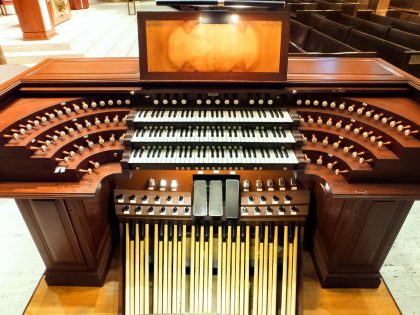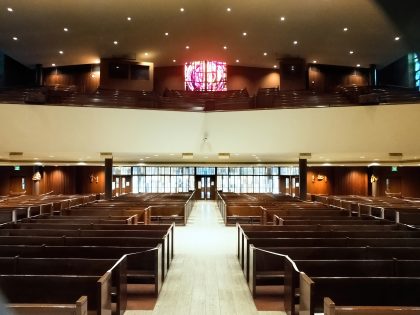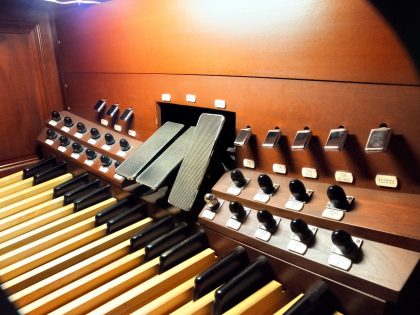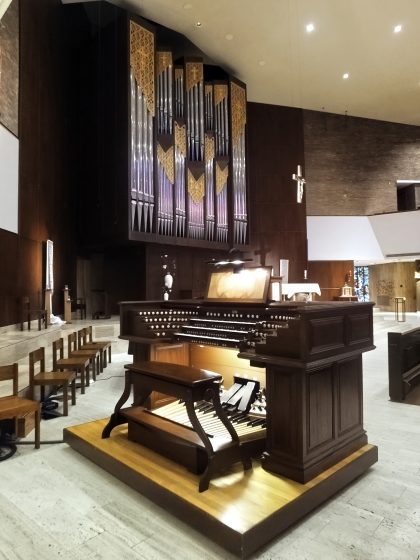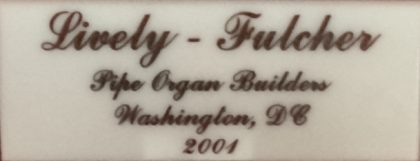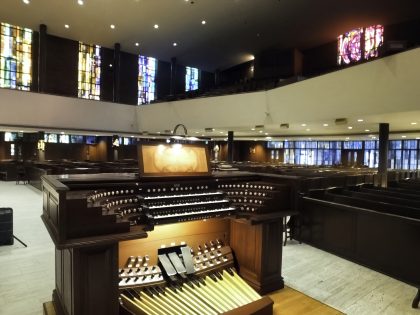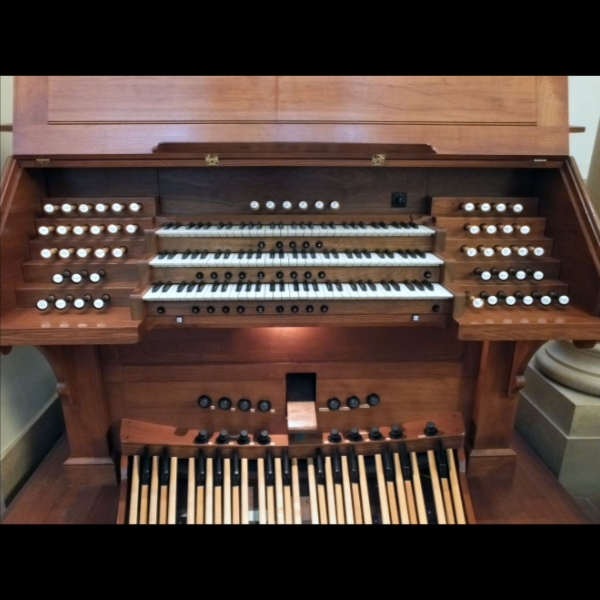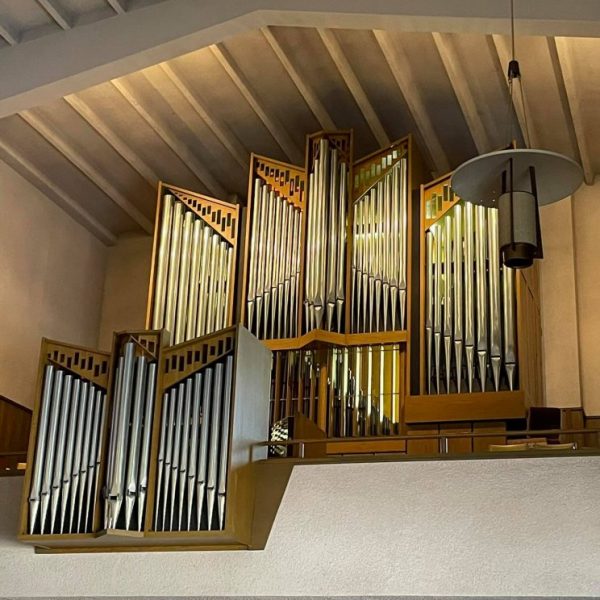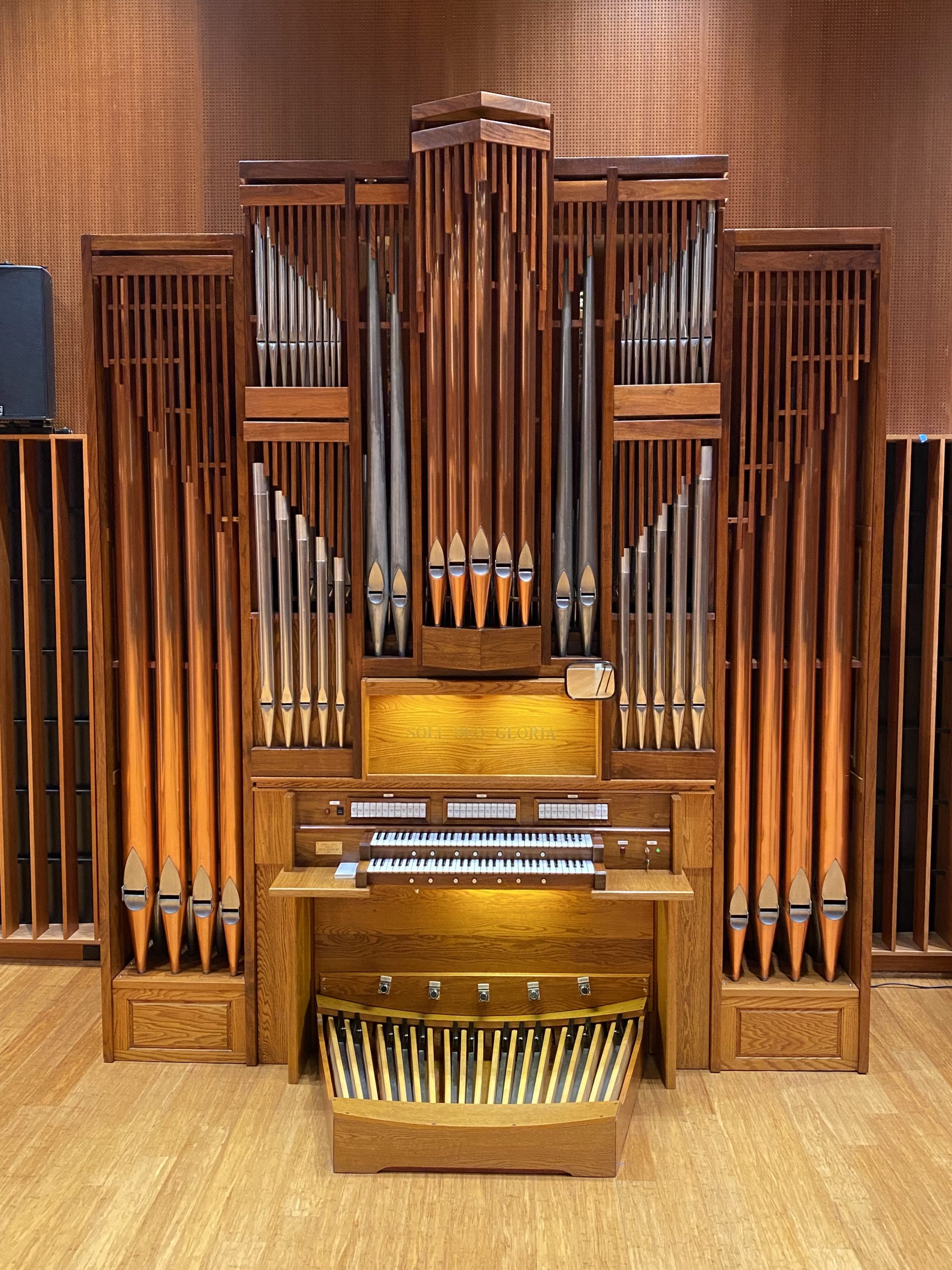St. Olaf Roman Catholic | Minneapolis, MN
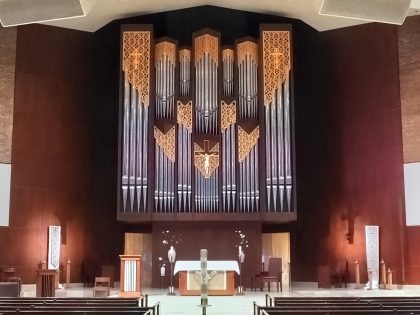 In 1997, Fr. John Forliti, Pastor, appointed Dr. Merritt Nequette and a parish committee to lead an organ project at St. Olaf. The committee enlisted the services of Dr. Jonathan Biggers, a recognized organ consultant. After a thorough study, Lively-Fulcher Organbuilders of Alexandria, Virginia, were chosen to build the new instrument which was installed and completed in July, 2001.
In 1997, Fr. John Forliti, Pastor, appointed Dr. Merritt Nequette and a parish committee to lead an organ project at St. Olaf. The committee enlisted the services of Dr. Jonathan Biggers, a recognized organ consultant. After a thorough study, Lively-Fulcher Organbuilders of Alexandria, Virginia, were chosen to build the new instrument which was installed and completed in July, 2001.
The organ was inaugurated in a series of concerts in 2002 beginning on February 9 with a service of blessing by Archbishop Harry J. Flynn, Archbishop of St. Paul and Minneapolis, and organ recital performed by Dr. Lynn Trapp, Director of Worship and Music, Organist, at St. Olaf Church. A hymn text by Delores Dufner, OSB was commissioned for the occasion. The series of inaugural concerts featured: a recital and master class by Swiss organ virtuoso, Guy Bovet; a program of organ and contemporary music with Twin Cities artists; Pipedreams Live, hosted by Michael Barone of Minnesota Public Radio and performers of the Liturgical Organists Consortium; field days for elementary students to learn about the king of instruments; and an organ and orchestra concert with Dr. Jonathan Biggers, organist, and the Kenwood Chamber Orchestra, orchestra in residence at St. Olaf Church, conducted by Ken Freed. This concert included the premiere of a commissioned work for organ and orchestra composed by Richard Proulx.
The instrument has 61 stops and 67 ranks (49 independent registers) playable over five divisions, Grand Orgue, Récit Expressif, Positif Expressif, Bombarde and Pedale. The manual and pedal key actions make use of electric slider windchests and the stop action is electric, complete with state of the art combination action, 256 levels of memory and a sequencer. The wind supply is regulated by a traditional bellows system linked to the wind chests by wooden wind lines. The console is built in a low profile, curved jamb configuration to enhance the organist’s ability to follow the Liturgy and conduct the choir. The console has natural keys covered in bone and sharp keys of solid ebony. The internal layout of the divisions within the organ case places the Positif Expressif centrally in the lower middle of the case and the Grand Orgue above that with the Récit Expressif behind the Grand Orgue. The Bombarde reeds are located in the Positif box and the Pedale division is divided on either side of the manuals and behind the 16-foot Pedal towers in the case.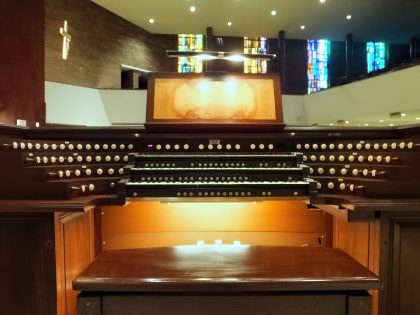
The casework, constructed of African mahogany, takes its inspiration from the contemporary architecture of the room and has simple Scandinavian design elements yet a firm traditional layout. The façade pipes are made of 72% tin and include pipes from the Grand Orgue Montre 16′, Montre 8′ and Pedal Montre 8′.
The organ is completely housed within its own freestanding casework and because of the deep gallery around three sides of the room is positioned at the front center of the church to enable it to fill the room with sound. A Cymbelstern stop — a group of small bells — is provided on the instrument and the church’s tower bells can be played from the Récit keyboard. The design of the pipe shades for the instrument is tied to the rich traditions associated with St. Olaf. They are made of basswood with patterns of dragons, eagles and serpents which are found in the Book of Kells. These designs are slightly earlier than King Olaf’s time, but they are strong Scandinavian symbols from the period. The cross piercing the crown is based on an 8th century piece made for St. Rupert. The crown motif was specifically chosen to represent St. Olaf and the crosses and crowns are covered with 24-carat gold leaf.
The tonal inspiration for the instrument is firmly based in 19th century France but is designed and voiced with a broad literature base in mind due to the varied uses for the instrument with the extensive music program at St. Olaf. The Tutti is robust to support large choirs, orchestra, and the singing of a capacity crowd of worshipers. The organ has a wide variety of soft colors as well. The broad foundation tone of the 8-foot stops and thick-walled expressiveness of the Récit and Positif boxes ensure the accompanimental versatility necessary for the performance of choral and solo literature. The warm yet clear polyphonic competence of broadly scaled principal chorus work carefully blended with the sonorous mutations and reed colors associated with Clicquot and Cavaillé-Coll make for an exceptionally versatile medium for the main body of the organ literature. The careful voicing and blending of individual stops coupled with the balancing and color requirements are important to specific areas of the French, German and English literature and ensure a convincing performance of the wide range of literature that is expected from modern instruments. This instrument is not meant as a copy of any one style nor is it intended to be a collection of styles trying to do everything, but rather – through its unique scaling, voicing and balancing – is intended to be a modern instrument of the 21st century speaking with its own voice.
The partners of Lively-Fulcher Organbuilders have a collective experience of over 75 years of organ building. Mark Lively, Paul Fulcher, and Patrick Quigley have been involved in the construction and installation of organs all over the world, from small residence-sized instruments to large cathedral and concert hall instruments. Their purpose is to offer a unique style of voicing and building and to produce organs, one at a time, that are of the highest artistic equality using the finest materials available.
Encryption
The samples are offered in 48kHz/24bit resolution. The multiple releases have 2 or 3 levels: short, mid and long. Hauptwerk 5 and higher required (incl. HW6). The sample set is encrypted via the iLok system used in Hauptwerk
The sample set is offered in a 4-channel variant (Close-Ambient), both perspectives show the reverb very well and are very clear, the ambient sound is not quite as focused, but not at the expense of clarity. It would be possible in order to save memory to load only one perspective, and still get a very good impression of the room. Sliders are provided to allow for mixing the perspectives to your taste, as well as sliders to independently detune flues, upperwork and reeds.
Reverb time
The reverb time is up to 3~4 seconds.
Keyboards, pedalboards
The original compass: keyboards - 61 notes, pedal division - 32 notes.
Requirements
RAM consumption (4-channel)
- 16-bit, compressed, all releases, single loops: 14 GB
- 20-bit, compressed, all releases, single loops: 26 GB (recommended)
- 24-bit, compressed, all releases, single loops: 29 GB
Sampleset Interface
| GRAND ORGUE | RÉCIT EXPRESSIF | ||||
|---|---|---|---|---|---|
| 16' | Montre | 16' | Bourdon | ||
| 8' | Montre | 8' | Diapason | ||
| 8' | Flûte à cheminée | 8' | Viole de gambe | ||
| 8' | Flûte harmonique | 8' | Voix céleste | ||
| 8' | Violoncelle | 8' | Cor de nuit | ||
| 4' | Prestant | 4' | Prestant | ||
| 4' | Flûte ouverte | 4' | Flûte octaviante | ||
| 2 2/3' | Quinte | 2' | Octavin | ||
| 2' | Doublette | 2' | Plein Jeu IV | ||
| 2' | Fourniture V | 2 2/3' | Cornet II | ||
| 8' | Trompette | 16' | Basson | ||
| 4' | Clarion | 8' | Trompette harmonique | ||
| Tremulant | 8' | Hautbois | |||
| Octaves graves | 8' | Voix humaine | |||
| Récit sur G.O. | 4' | Clairon harmonique | |||
| Positif sur G.O. | Tremulant | ||||
| Bombarde sur G. O. | Octaves graves | ||||
| POSITIF EXPRESSIF | BOMBARDE | ||||
| 8' | Montre | 16' | Tuba magna | ||
| 8' | Bourdon | 8' | Tuba mirabilis | ||
| 8' | Flûte douce | 4' | Cor harmonique | ||
| 8' | Flûte céleste | 8' | Cornet (tg) V | ||
| 4' | Prestant | PEDALE | |||
| 4' | Flûte conique | 32' | Contrebasse | ||
| 2 2/3' | Nazard | 16' | Grosse flûte | ||
| 2' | Doublette | 16' | Montre (G.O.) | ||
| 2' | Quarte de nazard | 16' | Soubasse | ||
| 1 3/5' | Tierce | 16' | Bourdon (Réc) | ||
| 1 1/3' | Larigot | 8' | Montre | ||
| 1' | Fourniture IV | 8' | Flûte | ||
| 8' | Trompette | 8' | Bourdon | ||
| 8' | Cromorne | 4' | Prestant | ||
| Tremulant | 4' | Flûte ouverte | |||
| Ocatves graves | 2 2/3' | Fourniture IV | |||
| Récit sur Positif | 32' | Contre bombarde | |||
| Bombarde sur Positif | 16' | Bombarde | |||
| Positif unison off | 16' | Basson (Réc.) | |||
| G.O. /Positif manual transfer | 8' | Trompette | |||
| Chimes sur G.O. | 4' | Clairon | |||
| Tower Bells sur Récit | Tirasse GO | ||||
| Cymbelstern | Tirasse Pos. Expr. | ||||
| Tirasse Bom. | |||||
| Tirasse Réc. |
All of our updates are cumulative, so you don't have to remember what order to apply them in... simply download and install (choose "Upgrade"option).
Click HERE to download the most recent update (July 11, 2022)
![]() Purchase for $349 US – you will be redirected to our fulfillment service, Fastspring
Purchase for $349 US – you will be redirected to our fulfillment service, Fastspring
Applicable taxes/VAT will be added for your location
![]() Purchase a fully-function 2-week demo for $4.99 US – you will be redirected to our fulfillment service, Fastspring
Purchase a fully-function 2-week demo for $4.99 US – you will be redirected to our fulfillment service, Fastspring
Note: only one demo set per customer per sample set

